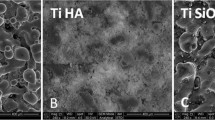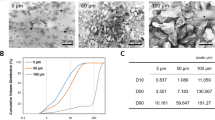Abstract
DNA synthesis and collagen formations on the implant material by cell culture in vitro are the most important phenotypical expression to estimate the biocompatibility. In this part, DNA synthesis and collagen formation on implant materials were quantitatively and qualitatively estimated by radioactive isotope H+ -thymidine to incorporate into DNA chains, H+ -proline to incorporate into type I collagen proteins followed by scintillation counting and antibody-antigen immunocytochemistry staining, respectively. Research results demonstrate that hydroxyapatite (HA) stimulates DNA synthesis and collagen formation on the material whereas this stimulation is restricted by adding spinel to the materials. There are statistical differences between the influences of material components on both DNA synthesis and collagen formation. It is supposed that porous materials can supply more platforms for cell anchoring, and more DNA and collagen are synthesised on the porous materials. Immersion in culture medium results in new HA crystal formation on the porous HA materials.
Similar content being viewed by others
References
Itakura Y, Kasugi A, Sudo H, et al. Development of a new system for evaluating the biocompatibility of implant materials using an osteogenic cell line (MC3T3-E1)[J]. J Biomed Mater Res, 1994, 22: 613–622.
Dubois J C, Exbrayat P, and Couble M L, et al. Effect of new machinable ceramic on behaviour of rat bone cells cultured in vitro[J]. J Biomed Mater Res, 1998, 43: 215–225.
Sautier J M, Nefussi J R, Forest N. In vitro differentiation and mineralization of cartilaginous nodules from enzymatically released rat nasal cartilage cells[J]. Biol Cell, 1993, 78: 181–189.
Van der Rest M. Bone matrix and bone specific products, bone (Vol. 3)[M]. Flowida: CRC Press, 1991, 187–233.
Buckwalter D J A, Cooper R R. Bone structure and function. In international course lectures[J]. The American academy of orthopaedic surgeons, 1987 36: 27–48.
Buckwalter D J A, Glimcher M J, Cooper R R, et al. Bone biology[J]. Bone and Joint Surg, 1995, 77–A(75): 1256–1275.
Bauer G. Osseo-integrated implant (Vol. 1)[M]. Florida: CRC Press, 1990, 81–87.
Hunt J A, Williams D F. Quantifying the tissue response to implanted materials[J]. Biomaterials, 1995, 16: 167–170.
Ruan J, Haung B, Mcgee T D, et al. A study of bioceramic composite materials[J]. Funct Mater, 1993, 24: 261–265.
Wen J, Huang B, Ruan J, et al. Study of bi-active CP-spinel composites[J]. J Central South Inst Min Metallur, 1993, 25: 348–352.
Ishaug S L, Grane G M, Miller M J, et al. Bone formation by three-dimensional stromal osteoblast culture in biodegradable polymer scaffold[J]. J Biomed Mater Res, 1997, 36: 17–28.
Bagambisa F B, Joos U. Preliminary studies on the phenomenological behaviour of osteoblasts cultured on hydroxyapatite ceramics[J]. Bimaterials, 1990, 11: 50–56.
Knabe C, Gildenhaar R, Berger G, et al. Morphological evaluation of osteoblasts cultured on different calcium phosphate ceramics[J]. Biomaterials, 1997, 18: 1339–1347.
Groessner S B, Tuan R S. Enhanced extracellular matrix production and mineralization by osteoblasts cultured on titanium surfaces in vitro[J]. J Cell Sci, 1992, 101: 209–217.
Carlsson L, Rostlund B, Albrektsson T, et al. Removal torques for polished and rough titanium implants[J]. Int J Oral Maxillofac Implant, 1988, (3): 21–24.
Wilke H J, Claes L, Steineman S. Clinical implant materials: advances in biomaterials, (Vol. 9)[M]. Amsterdam: Elsevier, 1990. 309–314.
Buser D, Schenk R K, Steinemann S, et al. Influence of surface characteristics on bone integration of titanium implants. A histomorphometric study in miniature pigs[J]. J Biomed Mater Res, 1991, 25: 889–902.
Okamoto K, Matsura T, Hoskawa R, et al. RGD peptides regulate the specific adhesion scheme of osteoblasts to hydroxyapatite but not to Titanium[J]. J Dent Res, 1998, 77: 481–478.
Lemons J E. Ceramic: past, present, and future[J]. Bone, 1996, 19: 121–128.
Gregoire M, Orly I, Menanteau J. The influence of calcium phosphate biomaterials on human bone cell activities. An in vitro approach[J]. J Biomed Mater Res, 1990, 24: 165–177.
Nefussi J R, Boylefevre M L, Boilekbache H, et al. Mine-ralisation in vitro of matrix formed by osteoblasts isolated by collagenase digestion[J]. Differentiation, 1985, 29: 160–168.
El-Ghannam A, Ducheyne P, Shapiro I M. Porous bioactive glass and hydroxyapatite ceramic affect bone cell function in vitro along different time lines[J]. J Biomed Mater Res, 1997, 36: 167–180.
Author information
Authors and Affiliations
Additional information
Foundation item: British Biological Science and Research Council
Biography of the first author: RUAN Jian-ming, doctor of bioengineering, born in 1957, majoring in biomaterials & tissue engineering.
Rights and permissions
About this article
Cite this article
Ruan, Jm., Grant, M.H. Biocompatibility evaluation in vitro. Part II: Functional expression of human and animal osteoblasts on the biomaterials. J Cent. South Univ. Technol. 8, 75–82 (2001). https://doi.org/10.1007/s11771-001-0030-7
Received:
Published:
Issue Date:
DOI: https://doi.org/10.1007/s11771-001-0030-7




